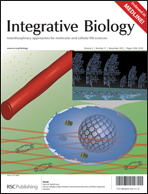Enhanced contractility with 2-deoxy-ATP and EMD 57033 is correlated with reduced myofibril structure and twitch power in neonatal cardiomyocytes
Abstract
As cardiomyocytes mature, their sarcomeres and Z-band widths increase in length in order for their myofibrils to produce stronger twitch forces during a contraction. In this study, we tested the hypothesis that tensional homeostasis is affected by altering myofibril forces. To assess this hypothesis, neonatal rat cardiomyocytes were cultured on arrays of microposts to measure cellular contractility. An optical line scanning technique was used to measure the deflections in the microposts with high temporal resolution, enabling the analysis of twitch force, twitch velocity, and twitch power. Myofibril force production was elevated by vector-mediated overexpression of ribonucleotide reductase (RR) to increase cellular dATP content or by adding the inotropic agent EMD 57033 (EMD). We found that RR and EMD treatment did not affect cardiomyocyte twitch force, but it did lead to reduced twitch velocity and twitch power. Immunofluorescent analysis of α-actinin revealed that RR-over-expressing cardiomyocytes and EMD-treated cardiomyocytes had lower spread area, sarcomere length, and Z-band width as compared to control cells. These results indicate a correlation between myofibril structure and cardiac power. This correlation was confirmed by exposing the cells to the myosin II inhibitor blebbistatin, and then subsequently washing it out. After wash-out, cardiomyocytes exhibited a reduction in twitch force, velocity, and power due to shorter sarcomere length and Z-band widths. Our results suggest that cardiac myofibril structure is regulated by tensional homeostasis. If myofibril-generated forces in cardiomyocytes are elevated, a state of tensional homeostasis is maintained by producing sufficient twitch forces with a lower degree myofibril structure.


 Please wait while we load your content...
Please wait while we load your content...